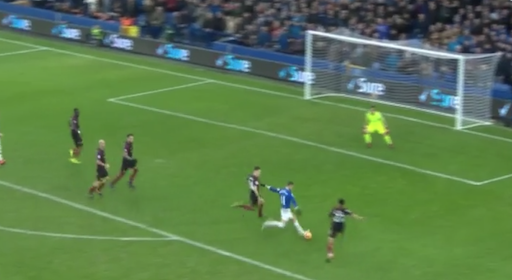WORLD CLASS COACHING
Pep Guardiola Defending
By Luca Bertolini
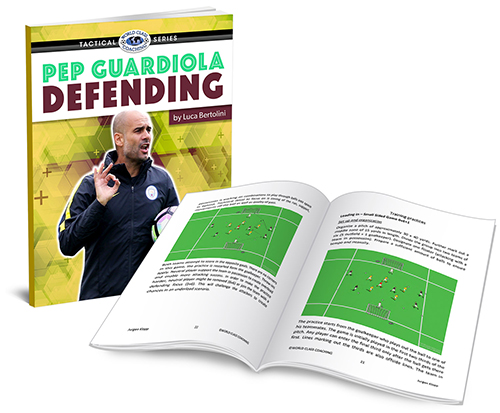
Table of Contents
PART ONE
Introduction
2016/17 Defensive Failures
PART TWO
Transition to Defending and Counter-Pressing
PART THREE
2017/18 Team, Data and Key Players
PART FOUR
Guardiola's Defensive Principles
INTRODUCTION - A Difficult Week
04/04/18 - Liverpool 3:0 Manchester City (Champions League Round of 8 - 1st leg)
07/04/18 - Manchester City 2:3 Manchester United (Premier League)
10/04/18 - Manchester City 1:2 Liverpool (Champions League Round of 8 - 2nd leg)
After three defeats in a row against English teams Guardiola stated: "We lost against Liverpool, against United and then against Liverpool. I have to analyze what we’ve done in 10 months and I think it’s quite good".
"I was today with my chairman. I saw the body language of my players. You won’t find a team who can keep the same momentum, the same rhythm and the same pace with this amount of games. It’s almost impossible".
"We would have liked to win the Premier League in the last game (against United) and it was our dream to get through to the (Champions League) semi-finals. But we have to reflect and think what we can do better next season".
"Last season it was the round of 16, this season it’s the quarter finals, hopefully next season we can go to the semi-finals".
He is talking about few games and about a difficult week and not about the issues of his method.
As we have already found out in the first volume, after a first 2016/2017 season without titles, Guardiola was talking about like this:
"But I know we will be judged on the titles we have won. My period in Munich was judged like a disaster because we were not able to win the Champions League. We won three leagues in a row, we won two cups from three, we arrived every time in the semi-finals and finals, but it was judged a disaster.
“Of course. I thought ‘If it doesn’t work, I’ll go home, another one is coming and someone can try in his way’, so in that moment there was concern about the results, what we can do is to improve” [...].
“In that moment I thought that could happen, that it doesn’t work [...].
“But at the same time, I thought if next season it’s not going well, if it’s the same, Txiki (Begiristain, City’s director of football) or Ferran (Soriano, City’s chief executive) would decide ‘OK Pep you are not good enough’ and change”[...].
The 2016/2017 season defending failures
We may say that the worst defeats of the first season were against Everton and Leicester, when City conceded 4 goals in both the matches, showing wrong team shapes when not in possession and even during possession and attacking phases of play.
In the first match against Leicester, on 2016 December the 10th, City played with a back line of 3; Fernando and Zabaleta were positioned in front of them to support the build up phase. But this 3-2 defensive formation when in possession failed, conceding 2 goals inside the first 5 minutes.

A big space was very clear on the left side of City middle third, as well as a large distance between the center back Stone and the left center back Kolarov; moreover Kolarov wasn't placed enough toward the center, Leicester forwards, Vardy and Slimani were then able to get in between the defensive lines, cutting off Zabaleta and Fernando as passing options.
City had to play long balls or pass side by side to maintain the flow of play; Leicester defended with two very compact lines of four in the center. Manchester City tried to build up from the flanks, but counter attacks were conceded after the loss of possession.
Here's the same situation but as it was managed during the second season: the back three were not placed on the same lines and the new right fullback Walker is a more defensive player. Delph, on the other side was the inverted fullback, exploiting his skills as midfielder to support the balance teammate.

The first goal of the match was scored by Leicester because of the positioning we were talking about before; Mahrez received in between the lines and he played toward Slimani with a one-touch pass...

...Slimani was then able to be positioned toward the opposition goal and to play on the Vardy's run over the last defense line as the back three were again positioned on the same line without chance of space coverage.

Stones was not able nor to close the passing lane toward Vardy, neither to follow him as he was placed frontally in relation to the opponent in possession.
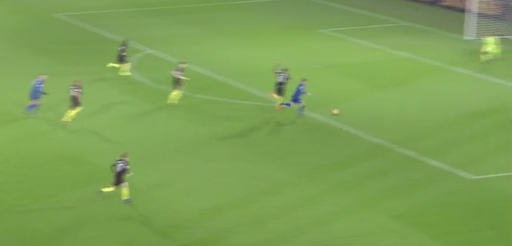
Kolarov were not able to cover the goal space because he was on late and not positioned between the opposition forward and his own goal.
Vardy was then able to finish in front of the opposition goalkeeper.

City was often vulnerable after the loss of possession because of a unique high defense line and individual mistakes. Stones had to decide whether to play 1 v 1 against Slimani or to catch up with Vardy, who positioned himself in the big space between Kolarov and Stones.
Vardy could easily overcome the direct opponent, being in a positional advantage in the 1 v 1 duel towards the goal when running inside from the flank.
The high intensity passing system failed in this match, as the team lost the defensive positions and the duels, and available spaces could be exploited for counter attacks. This was highlighted during the move that led to the fourth goal.
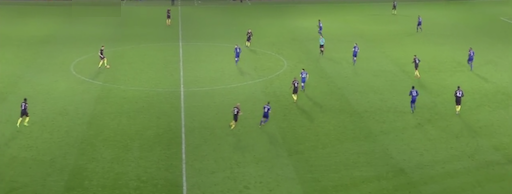
The defense line has the possession, but the players were not shaped in a proper way, being too far from one another...
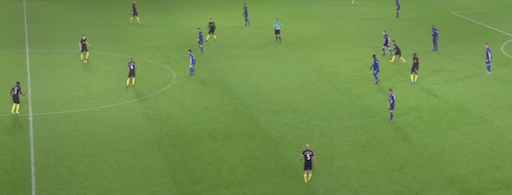
...and they were untidy in case of loss of possession also. If the player in possession in this footage had lost the possession, there wouldn't have been anyone to cover the space toward the goal.
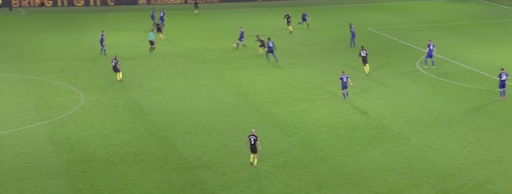
The possession was lost while taking the move to the final stage and because the coverage of the spaces near the ball was very poor again, as no one was able to close forward passing lanes.

The center back had to run out of his position to cover the space and he was able to win the ball, this time.

This is the sequence of the third conceded goal:
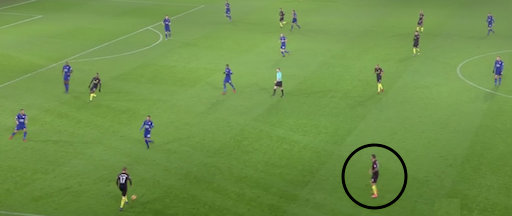
Kolarov took the position that he usually prefers when deployed as a left back during the build-up phase. Fernandinho would have dropped deep to cover the spaces.
8 City players were placed in the attacking half, creating a 2 v 2 duel at the back with positional advantage for Vardy and Slimani. The defense was then again exposed to long or through balls.
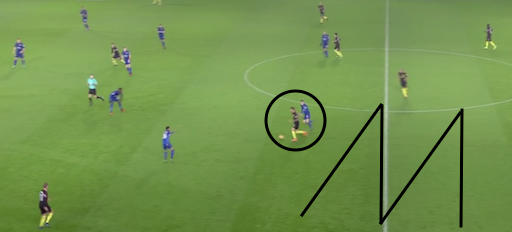
Kolarov dribbled the ball forward, leaving space behind him and Fernando didn't cover the position properly together with the center back.
In this sequence, Leicester caught up the ball; Vardy ran past Kolarov behind him.
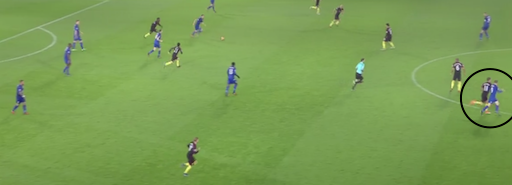
Wide spaces in the defensive half were left and they could be occupied and exploited by Mahrez as the Manchester City defenders played a very high line without depth coverage.
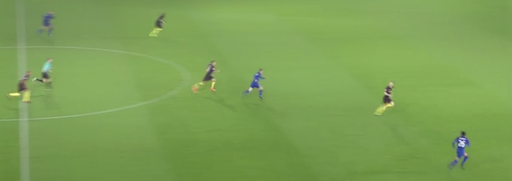
The 2 v 2 situation allowed Leicester players to be in positional as well as qualitative (thinking about their basic speed without the ball) superiority.
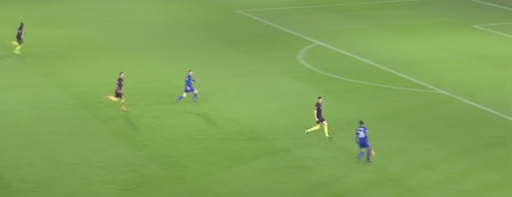
One good long ball from Fuchs found Mahrez in space who played to Vardy on his run.
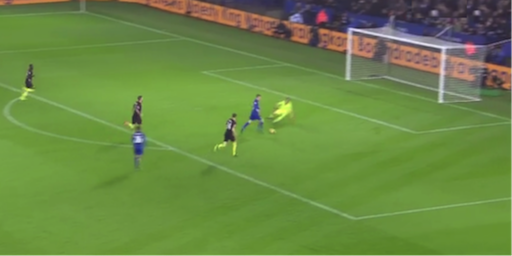
This was the first time in which Man City had conceded 4 goals. On this day, the defensive failures were terribly shown, as Leicester seemed to be so perfect in taking advantage of them.
Part of the blame was towards the players rather than the system, as individual mistakes and poor defensive shapes at the back caused the goals.
Guardiola suffered a second four goals defeat in the league against Everton, and this match is very interesting to understand how the shape on the field was so different during the first season, in relation to the second one, despite many different players.
The following formation shows Zabaleta as a right center midfielder in a diamond that was completed by Tourè as balance midfielder, De Bruyne on the left and Silva as a free "advanced midfielder".
Sterling played as a left-hand second forward behind Agüero with the idea to run to receive decisive passes through the space and between the opposition lines.
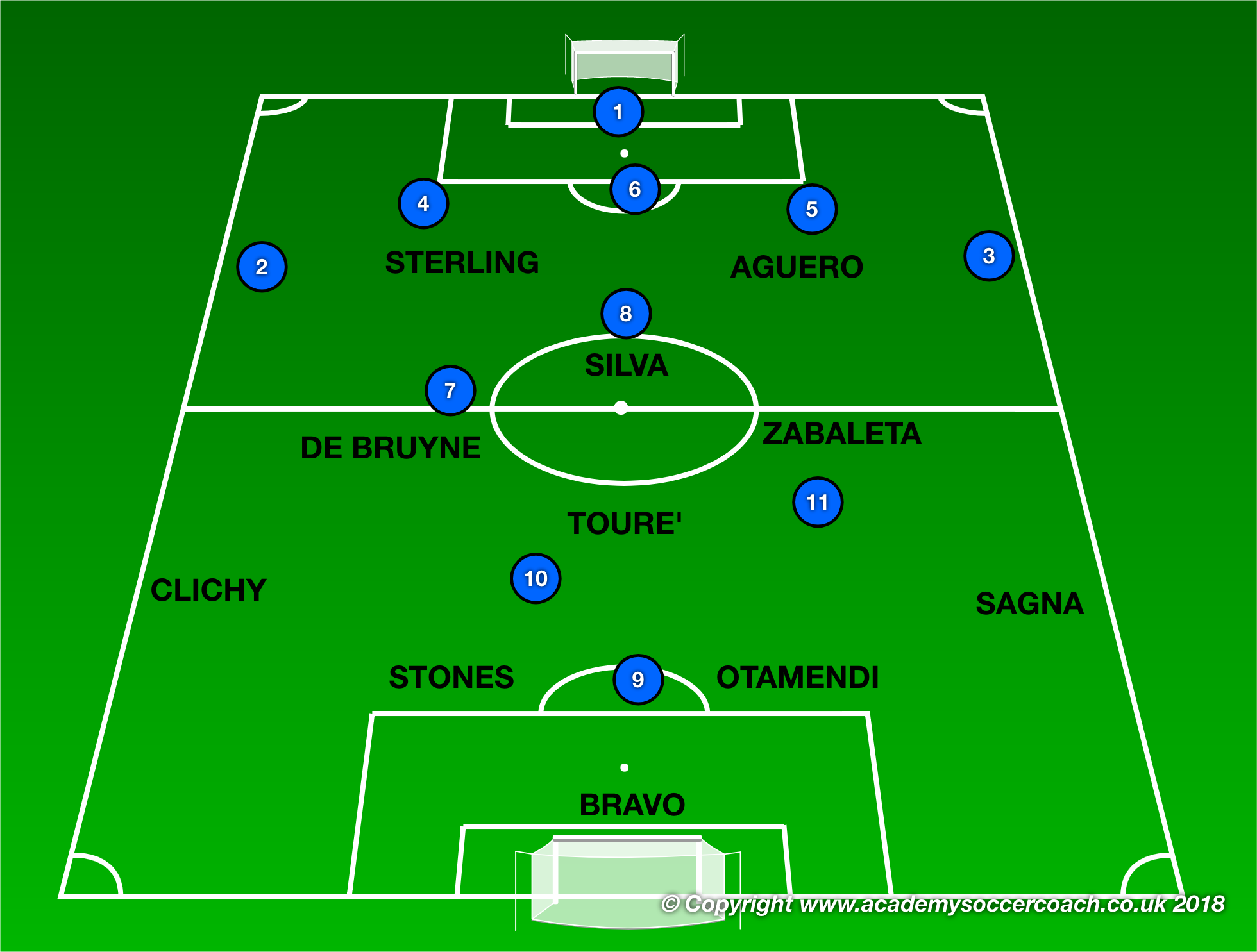
Everton played with a man orientation defense phase and City was surprised by its very good pressing decisions.
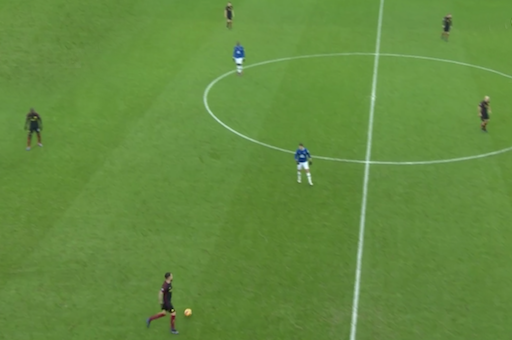
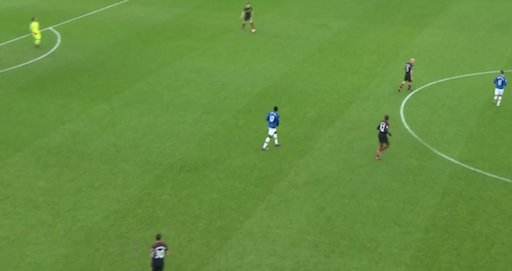
In this sequence Sterling came too deep, he couldn't receive as Davies and Mirallas easily covered him. Silva was marked by Barry but still comes deep for no reason just to play a backwards pass.
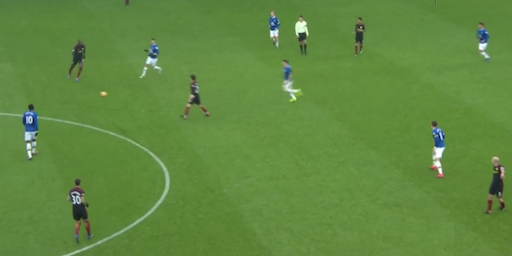
Everton’s three defenders could control Agüero and Sterling playing 3 v 2, also because there were no wingers. The Everton's fullbacks against Clichy and Sagna controlled the wider spaces next to the back three.
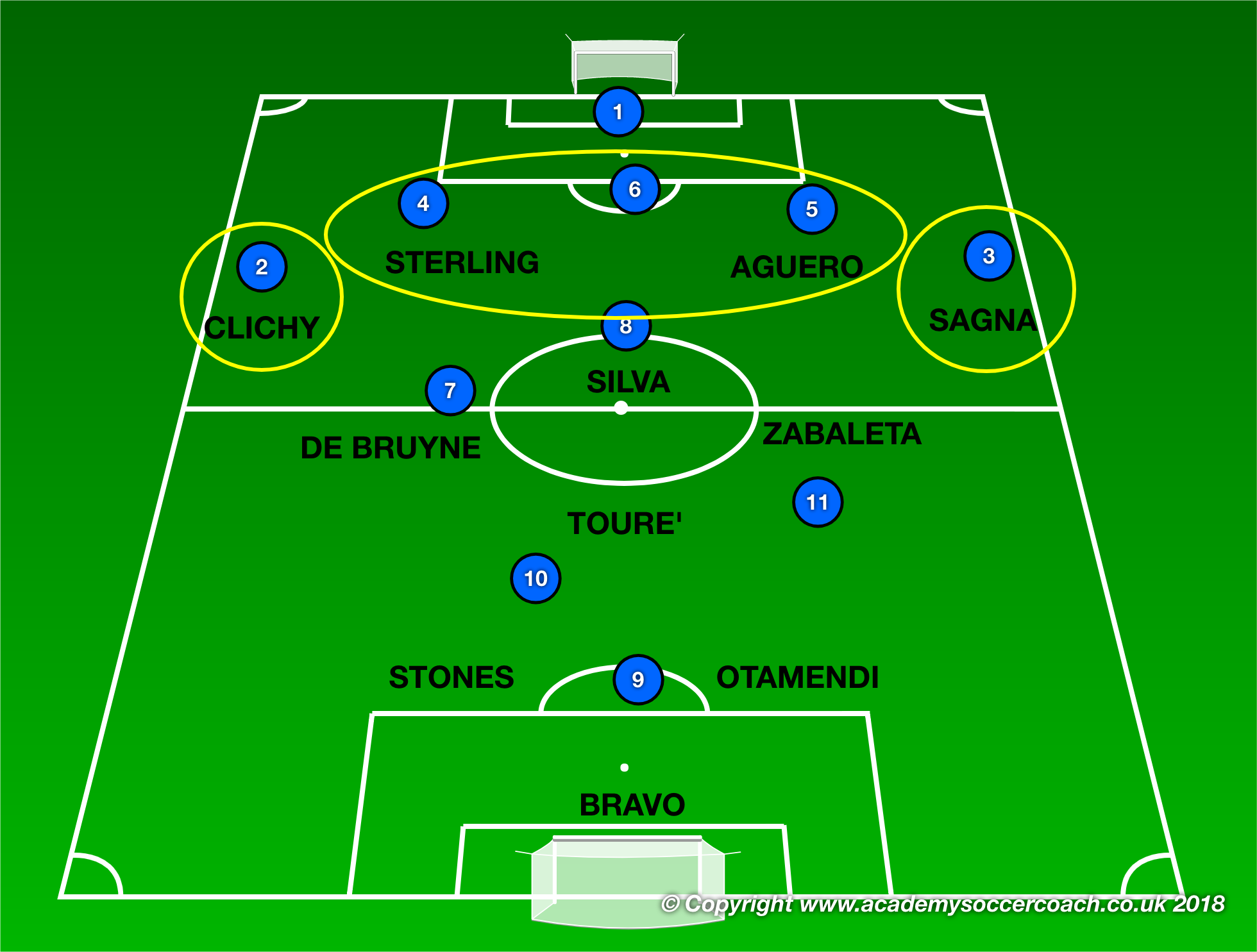
Everton players were able to be passive when high pressure was not possible to save the offensive passing lanes.
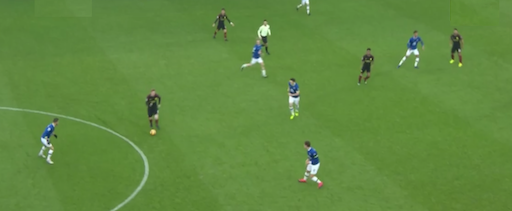
They suddenly played for ball recovery as soon as they could, creating defensive overloads; this was the reason why they could isolate City ball carriers. City could not play forward to the attacking line, but its players were forced to just circulate the ball along the middle third.
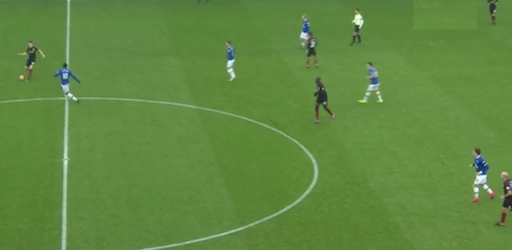
Sometimes Everton players even moved up into a high pressing and forced City playing long balls.
Three of Everton’s goals were scored after long balls into the left defense half space. They attempted to build up with clean passes, but City prevented that well; but, again, the depth was not covered properly.
Everton often played long balls even if they didn't have a proper team structures; but City fullbacks moved up early to attack Coleman or Baines, and they destabilized the defensive line. In the space in front of the back they had to face Lukaku, Mirallas, Davies and Barkley.
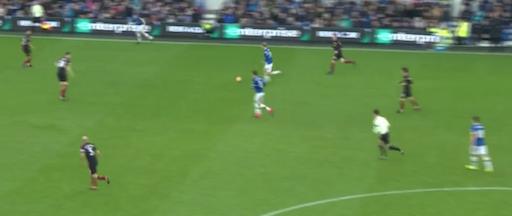
This way all the goals were created through the channel between Clichy and Stones.
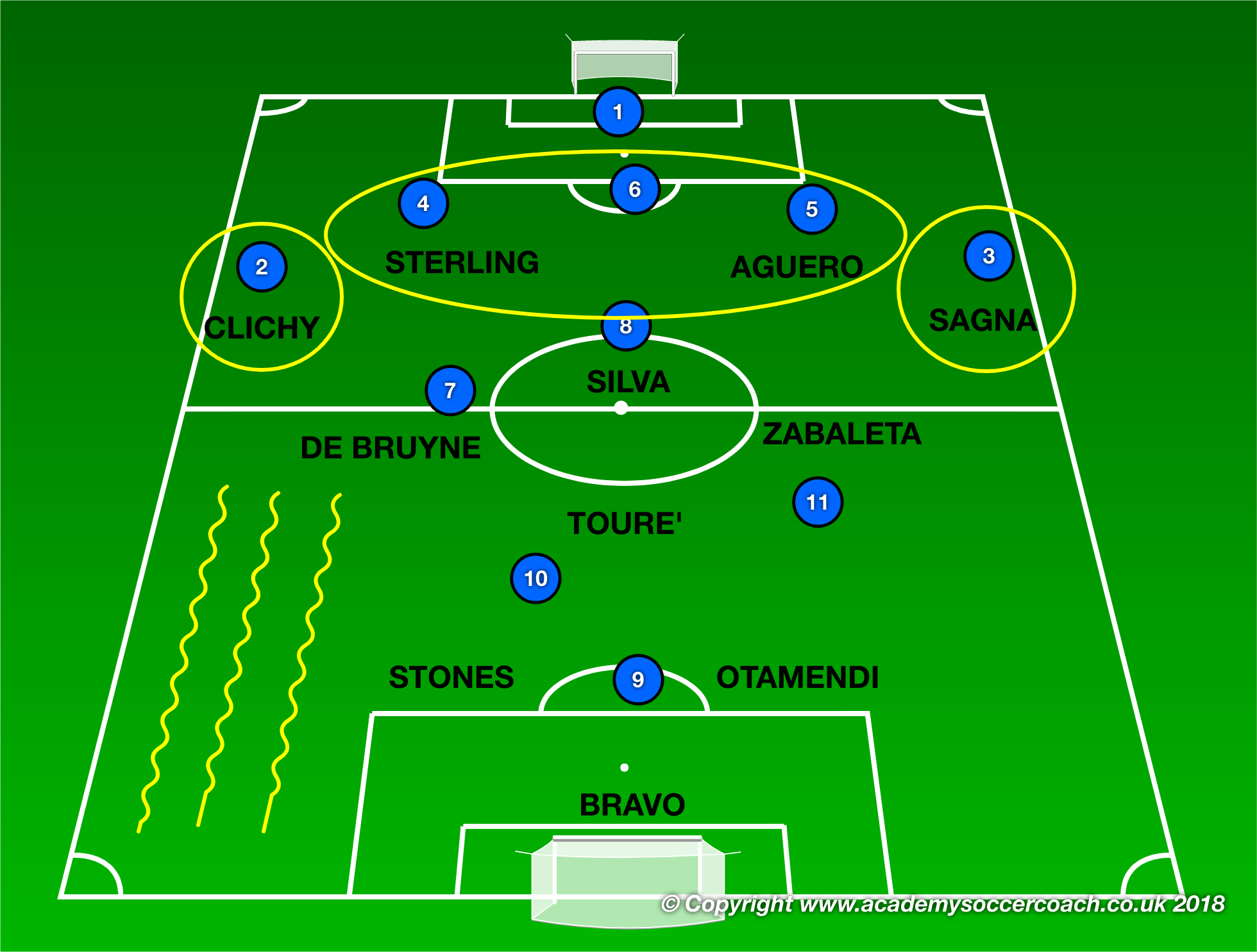
City especially had problems with their defensive orientation and communication: a pattern during all goals was players moving up to create pressure without anybody covering the spaces created by these movements.
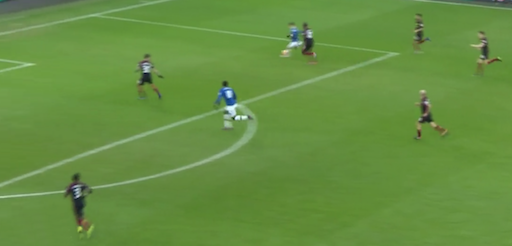

This is another clear example of missed pressure without space coverage inside the middle third and the following creation of a center gap between Stones and Otamendi.
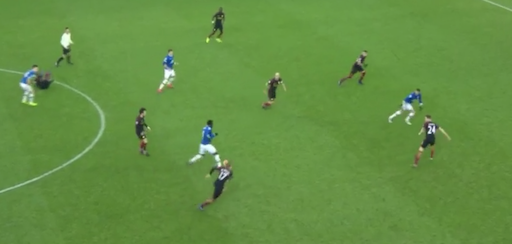
Clichy and Otamendi seemed to be confused by all the movements in midfield in these situations; Stones was clearly on late here and Otamendi was not covering the goal space properly as he would have to be placed backwards as last defender.
Clichy was not covering the spaces properly as he didn't reduce the gap with the center defender inside the first third while running back.
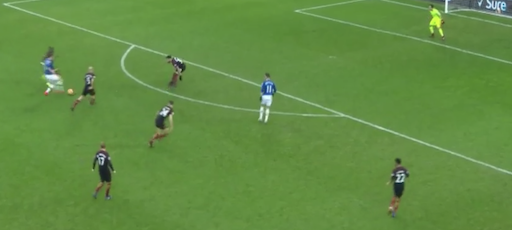
Touré’s defensive play was not on the same level of the previous seasons anymore and he couldn't be the sole defensive midfielder without problems.
Zabaleta switched between a balancing and an attacking role, moving around Touré, to help him, or positioned himself in order to be the defensive midfielder, but he was often on late as in this goal move. His role was as a classic fullback for the whole career.
In this situation, it's clear that in spite of a 2 v 1 duel on the ball and a general heavy numerical advantage 4+1 against one or two forwards, Everton players were often in positional advantage to finish.
